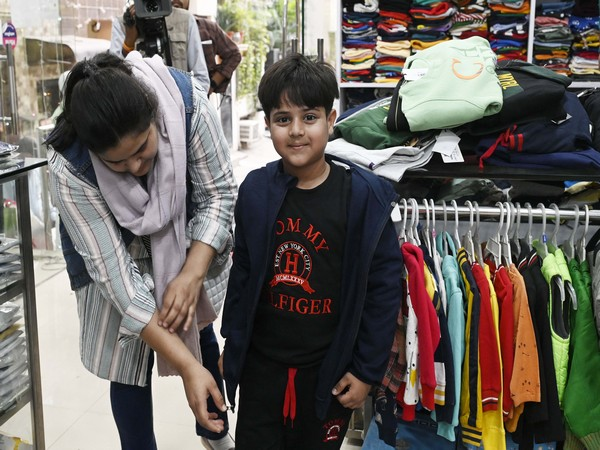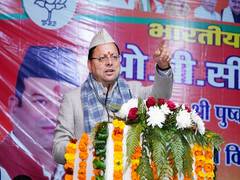Branded clothes jazz up children’s wardrobes, target growing Indian market
New Delhi [India], November 20 (ANI): Three-year-old Abeer, the youngest member of Delhi’s Krishna Nagar-based Sharma family, shows off his clothes with great interest and pleasure.

Even at a very young age, Abeer is selective about his clothes. He has a good collection of branded garments that he has got from his parents, grandparents and other relatives.
While buying clothes, Abeer’s parents do not just keep in mind their son’s favourite colours, but also the quality of the products.
“We prefer brands like H&M and Zara for our son because they are long-lasting and have durability. The clothes from these brands are of soft material” says Garima Sharma, Abeer’s mother.
When asked about the changing trends in kidswear, Abeer’s father, Rajan Sharma says that things have changed completely over the years. “When I was a child, I never wore branded clothes. We used to buy clothes in the local market, and there were not many brands to choose from. Now people have become more aware of brands”, says Rajan.
The globalisation of the Indian economy has led to a significant expansion of the clothing industry for children over time. Well-known clothing companies are found to be experimenting with children’s clothing in new ways.
Children now can choose from a wide variety of branded clothing options, whether they prefer to dress traditionally or in the newest fashions. Giving their children fancy clothing makes parents happy as well.
Delhi-based counselling psychologist Taanya Nagi tries to explain the thought process behind buying branded clothes for children.
Nagi opines that better sources of income have brought about a dramatic change in parenting.” Parents who could not use such luxury clothes, want them for their children. It gives them a sense of accomplishment. Furthermore, parents want an overall personality development of their children with a focus on their appearance and soft skills”, says Nagi. Taanya also connects the changing trend with transformation in the Indian market.
“Around 29 per cent of India’s population is under the age of 14. Hence India is a massive market for children’s clothing. Many international luxury brands have entered the Indian market such as Fendi, Gucci, Boss, U.S Polo and Allen Solly kidswear” says Nagi.
According to Fortune business insights, the global apparel market size for children was valued at USD 187.29 billion in 2022 and is projected to grow from USD 198.80 billion in 2023 to USD 318.34 billion by 2030, exhibiting a CAGR of 6.96 per cent during the forecast period.
In an era of social media there is also a growing trend of parents twinning with their children and posting pictures in matching outfits, with brands releasing adult and age-appropriate matching outfits. Fuelled by celebrities, social media is driving consumption patterns. The more time children spend on social media, the greater is their awareness about brands they have and the more willing they are to share their opinions on clothing choices.
Speaking about the role of social media Nagi says, “Indian kids and teenagers are highly influenced by social media and very well informed by the latest global fashion trends. Peer pressure also prompts teenagers to compete and copy each other in the latest dressing style. When their family have the buying power, they feel “Why not”?
According to the data provided by the International Market Research and Consulting Group, the Indian kids’ apparel market surged to USD 21.1 billion in 2022, with projections showing an expected expansion to USD 24.5 billion by 2028.
Aggressive business and promotion strategies have fuelled the growth of the children’s apparel market. Currently approximately 375 million people in India are below the age of 15 years. This represents a huge consumer base for the apparel market for children. Spurred by the strong economic growth in recent year and disposable incomes in India retail buying has been witnessing a continuous growth. This has resulted in an increasing spending on clothes by parents for their wards.
Recently, the 78th edition of Junior’s Fashion Week was organised in New Delhi which showcased a number of emerging brands such as Lee Cooper, Mulyo, One Friday, Nike and many more. Children were spotted confidently ramp-walking around in trendy trousers and hoodie t-shirts, demonstrating that they don’t want to fall behind in the fashion world.
Priyanka, the director of Junior’s Week feels that there were different brands available for adults but very less brands were available for kids in the market. “When we see now, there are different adults’ brands who have come up with their kids segment also like Lee Cooper. They have their whole range of kids – for boys as well as for girls because they have got good response from their customers who would like to purchase same brand clothes for their kids”, she said by adding that kids are now very fashion centric these days.
Not only are international brands targeting the fashion market for children, but Indian brands are also optimistic about this fast expanding segment.
Shambhavi Jaiswal, the founder and CEO of Indian brand Mulyo said, “What we are giving the market is a fusion of a lot of things. And Mulyo is working on the trends that are coming to the market”.
Jayesh Sali, head of marketing, Reliance Retail – Fashion and Lifestyle believes that the Indian market for kids’ apparel is booming at the moment, its flourishing as kids of today have their own choices and preferences.
“They are very well ware due to exposure towards social media. The kids in today’s time choose their own apparels, their own looks, their own style”, he said while adding that the industry is at its pinnacle at the moment where everyone is embracing the trend.
The double income parents with their single kids in Tier I and Tier II cities across India are spending lavishly on buying branded clothes and other accessories. This has opened a new market for a large number of international and Indian apparel brands.
The growth of the Kid’s Wear industry is also pushed by expanding store space and online commerce. Due to television and social media, people are more aware of brands and their offers. Kids also easily identify with brands once they see a celebrity endorse it. To be seen wearing what that celeb wore is driving them to buy the best of brands.






